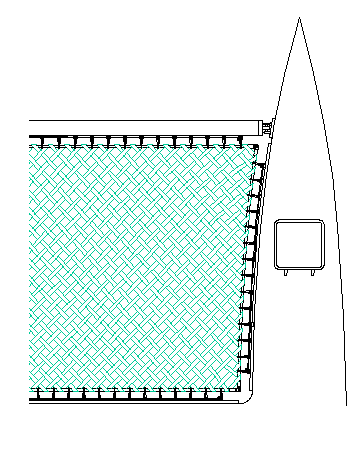How to Install Web Netting on Catamarans
Webbing nets offer the best combination of properties for larger
catamarans and trimarans. They can be woven with a variety of openness
configurations to suit the individual boat, and have exceptional strength
and stability. In order to insure that strength and stability, the
nets must be installed properly. How to install the webbing net depends
on the configuration of your boat and the attachment hardware in place.
This page describes some of the different methods that can be used, and their applications.
These recommendations are based on moderate sized nets for private use; larger
nets or those in commercial or other heavy use situations will want
greater support (I.e. shorter spacing, larger bolts, larger line).
In order to get a net that will hold weight without sagging it will
need to be laced on at least 2 sides. Typically, webbing nets are
laced on all 4 sides. Specific lacing patterns are discussed on the
lacing patterns page,
but the idea is to add up the cumulative tensions of each lacing wrap so that the total tension any one side
of the net will be enough to provide firm stable surface.
Webbing Nets are diagonally woven in a continuous weave pattern which
results in a series of webbing loops along the perimeter of the net.
Each of these loops must be supported to maintain proper net tension.
This is a key factor in the webbing nets strength, as 100% of the webbing
fibers are supported directly by the attachment system. It is possible
to lace each of these loops to the attachment hardware on the boat but
a better method is to insert a rigid tube or rod through each of loops
and lace that rod or tube to the attachment hardware on the boat. This
method supports the net more uniformly and eliminates the chance of
the lacing line chafing the webbing. Our nets are woven to accept tubes
or rods up to 1" in diameter and can be made to work with larger tubes
if necessary.

1" Webbing Net, 2" Average gaps,
Perpindicular
Lacing to battens overlaped and battens with End Caps
Battens
Round fiberglass battens offer excellent support for the perimeter
of the webbing nets. We have round battens in 5/8" and 7/16" diameters.
The 5/8" battens can be supported by lacing points as far apart as
12", while the 7/16" battens should be supported no further apart
than every 6". We now offer the battens painted with a hard polyurethane coating
to prevent UV damage to the fiberglass. The 5/8" battens are also
available in connectable lengths so they can be shipped easily and assembled
to full length at the time of installation. To provide a finished
appearance and prevent movement of the battens after instillation, End Caps can
be installed and bolted together at the corners. If End Caps are not
used, the battens should overlap in the corners and be lashed together.
In some cases it may be necessary to wire the battens together through
a drilled hole where they overlap to prevent movement. There are other
materials that will also work, such as; 1/2" sch. 80 PVC pipe, 3/8"
stainless steel rods, or 3/4" stainless or aluminum tubing.

Cables
The preferred method for attaching nets
to a cable would be to insert the cable through the webbing loops of
the net, eliminating the lacing on that side. This will need to be done
first before the remaining sides of the net are laced up. If you are
supporting a second side of the net with a cable the weight of the net
will apply enough tension to the cable to make attaching the fittings
difficult. This should be avoided if possible, as the cables do not
provide as much support as a solid structure and the net will not be
as firm. Cables should always be coated or covered in some way to protect
the webbing from chaffing damage.
Boltrope
A boltrope border can be attached to 1 side on a webbing net that can
be inserted into the Hull or Deck Track. This is not as strong as lacing
to battens and it adds to the price of the net but it will eliminate
the lacing and the lacing gap on that one side of the net.
Grommets
A reinforced border with grommets for lacing instead of the webbing
loops can be attached to any of the sides of the net. This is not
as strong as using the battens and usually costs extra, however, in some
situations where the net has large radius corners or is unusually
shaped it is a better solution as the net can be cut to shape and the border
attached to match any opening. This type of border would also be easier
to install.